Looking for a complete list of Influencer marketing statistics?
Then look no further!
*This article was updated in February 2018, updating old statistics and adding new influencer marketing statistics 2018. It is consistently updated so you always have up-to-date influencer marketing statistics from new studies as they are made. This means that this article has the most recent statistics, including the most recent ones from 2018.
Social media influencer marketing has exploded in popularity in just a few years. People are turning to influencers on social media for advice more than ever, and today, it is the influencers who have the true reach and trust. With that in mind, it doesn’t come as a surprise that 86% of marketers have used influencer marketing in the last year, nor that influencer marketing budgets are skyrocketing.
Before social media, there were no social media influencers. The only ones people looked up to were celebrities and possibly also the president. But what social media has done is it has given people a voice and an opportunity to build their very own influence and build a large and engaged audience.
As more and more people have started using social media, brands have started to realize the importance of leveraging social media for marketing. But brands have also started to realize that influencers can be leveraged to amplify their brand message and to have a trusted individual promote them.
As the interest in influencer marketing has skyrocketed in popularity, plenty of studies have been made which have presented quite interesting influencer marketing statistics.
In this article, we’re digging deep into the statistics of influencer marketing and the results it’s able to generate.
Contents
The ultimate list of Influencer marketing statistics
1. Influencer marketing content delivers 11X higher ROI than traditional forms of digital marketing.

2. 70 percent of teenagers say they trust influencers more than traditional celebrities.
As a brand, it’s difficult, if not impossible to build the trust influencers have. In fact, 54% of people don’t trust brands. However, with the help of influencer marketing, trust is transmitted to your brand. Also, instead of wasting your efforts on promoting yourself, which a large share of people obviously don’t trust, using influencers to speak for you will get your message listened to and trusted.

2. 6 in 10 follow advice from their favorite creator on what to buy over recommendations from celebrities.
It’s no secret that customers have a hard time trusting brands and what they say. Nor is it a secret that celebrities have lost the impact that they once had. Now, people are trusting social media influencers and peers more than anything else.

3. 86 percent of females turn to social media outlets for opinions and advice on what to buy.
This is especially relevant to brands that have women as their main target audience, but also relevant to brands who have them in their spectrum of ideal customers. If you want to reach women and get them to buy from you, influencer marketing is a must.
4. 72 percent of women turn to social media “frequently” for guidance in everyday purchase decisions.
These women turn to social media influencers ahead of anything else for inspiration. By getting your products seen in these contexts, you can increase your sales dramatically.
5. 49 percent of consumers rely on influencer recommendations.
At the same time, 54% of people don’t trust brands. These are two sides of the spectrum, but it’s no question of which side you want to be on. Partner with influencers and consumers will trust and rely on these recommendations. When consumers feel safe with the recommendations the influencer gives, they’ll follow through and buy the recommended product.
All thanks to a trust which brands will never be able to obtain.
6. 92 percent of consumers trust recommendations from peers on social media above all other forms of advertising.
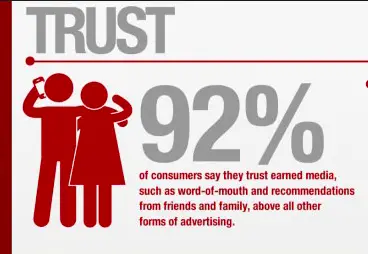
If you can get people to share your message and make it so that it’s presented in a genuine way, the message will be trusted by almost all consumers.
7. Influencer marketing campaigns generate $6.5 in earned media value for every $1.00 invested.
Invest $1 and get $6.5 back. Only a few marketing sources are able to replicate the same tremendous return on investment.
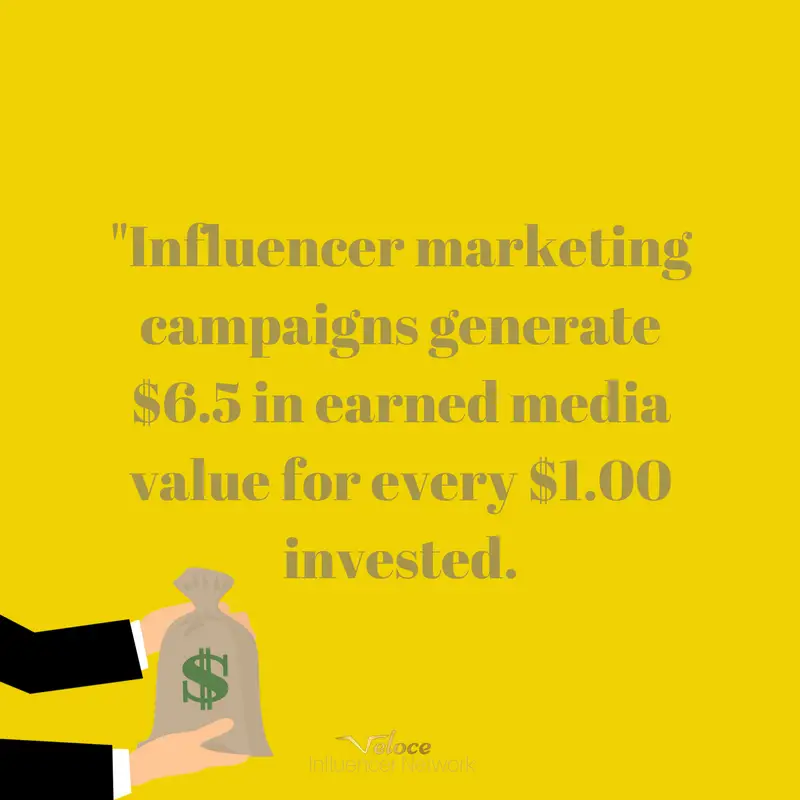
8. 13 percent of brands generate $20 in revenue for every dollar invested in influencer marketing.
For every dollar you invest, you get 20 back. If you succeed in creating an influencer campaign that comes off as genuine, and partner with an influencer who has a true impact on people, you too are able to achieve these incredible results.
9. 59 percent of marketers plan to increase their influencer marketing budgets over the next 12 months

Brands are only increasing spending budgets for one reason: the thing they are spending their money on at the moment is clearly generating results.
10. Influencer marketing has been rated as the fastest-growing online customer acquisition channel.
Influencer marketing is quickly growing traction. As more and more brands hop on the influencer marketing train, it is more important than ever to partner with influencers who truly resonate with your brand and that create an influencer campaign that is fully aligned with the values the influencer’s followers have. If you choose an influencer who doesn’t resonate with your brand, it could have the opposite effect instead.
11. 22 percent of marketers identify influencer marketing as the most cost-effective customer-acquisition method.
As we saw above, 13% of marketers see a $20 return on one dollar invested. There are only a few marketing sources that are able to generate the same ROI, so it doesn’t exactly leave us wondering how 22% of marketers say they find influencer marketing to be a cost-effective customer acquisition method.
12. 51 percent of marketers believe they can acquire better customers through influencer marketing.

By partnering with the right influencers, you only reach those who truly matter, and therefore also obtain better customers that are more relevant to your brand. Instead of running ads that you have zero clue about who they reach, influencer marketing helps you reach potential customers of yours, and do it with the help of a trusted individual.
13. 57 percent of companies in the fashion and beauty industry use influencer marketing in their marketing strategy.
The fashion and beauty industry is one of the industries that use influencer marketing the most. In fact, there are plenty of examples of beauty and fashion brands that have built their brands purely with the power of influencer marketing.
14.
When you can get your product exposure on a platform where millions of people spend their time, you’ll be able to impact them to the point where they buy from you.
15. In 2016, influencer marketing surpassed print marketing.
We’re seeing a transition in the way brands spend their marketing budget. Brands are going from the inefficient and expensive display and print ads to influencer marketing simply because IM can generate an ROI that print marketing can only dream of achieving.
16. 73 percent of all marketers claim they have an allocated budget for influencer marketing.
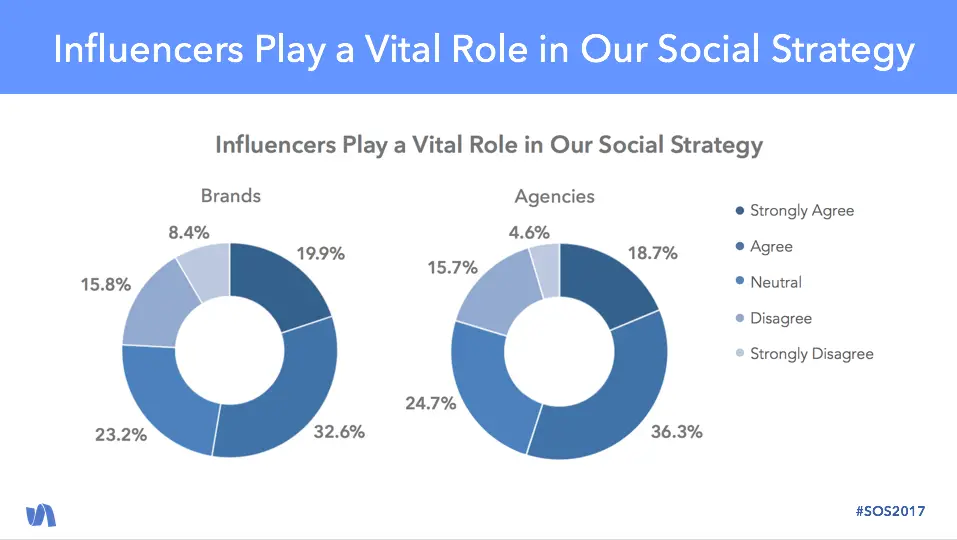
If you aren’t implementing influencer marketing into your marketing strategy, you’re already behind your competition. More and more marketers are starting to realize that influencer marketing is a tremendously powerful tool that they simply can’t afford to miss out on.
17. Google searches for the term “influencer marketing” has increased by 325 percent over 12 months.
Interest in influencer marketing is skyrocketing, and so should your budget allocated to influencer marketing.
18. More than 230 influencer marketing dedicated agencies have popped up in just 24 months.
As the interest in influencer marketing from brands has increased, the demand for influencer marketing agencies that help guide the brands to influencer marketing success has grown as well.
19. 67 percent of marketers report that they plan on increasing their influencer marketing budget in the next 12 months.
When almost 70% of marketers say they plan on increasing their budgets allocated towards influencer marketing, it’s nothing but a clear sign that influencer marketing works.
20. 84 percent of marketers find influencer marketing to be effective.
Set up an influencer campaign properly and you’ll find it effective as well!
21. 55 percent of marketers believe they get better marketing results with influencer marketing.
22. The influencer marketing industry is expected to reach $1.7B in 2018.

Brands are finally starting to acknowledge the incredible results influencer marketing is able to generate. Fail to implement influencer marketing in time and your competitors will already have dominated the marketing source when you decide to implement it.
Bottom line: the time is now.
23. The number of brand-sponsored influencer posts is expected to reach 12.9 Million in 2017 and close to double in 2018, reaching 24.2 Million sponsored influencer posts on social media.
Influencer marketing posts are growing exponentially and the growth doesn’t seem to slow down anytime soon. This is one of the most significant influencer marketing statistics as it proves in which direction influencer marketing is going. Of course, only time will tell, but as of now, and within the near future, the popularity will only increase.
24. 94 percent of brands who have used influencer marketing found it to be effective.
Create a strategy, set up goals, and use platforms like Veloce to identify influencers who are the perfect fits for your brand and you’ll be included in the 94%.
25. In 2016, marketers generally spent between $25,000 and $50,000 per influencer marketing program.
Influencer marketing spend is completely up to the brand. You can spend as little as $20 or spend as much as $500,000. More invested money doesn’t necessarily mean better results. But if you know how to spend that money in the right way, you’ll dominate influencer marketing and generate results you never thought were possible.
26. 40 percent of people say they have purchased a product online as a result of seeing it being used by an influencer on social media.
The impact influencers have on people is real. When influencers with true influence over people share a positive experience with a product, people are likely to want it as well.
27. Purchase intent is increased by 5.2X when Twitter users are exposed to promotional content from influencers on the platform.
Investigate which social media platforms are most suitable for your brand and choose them based on where your target audience is to be found. Just know that Twitter is a social platform that is immensely powerful.
28. 71 percent of marketers believe that an ongoing partnership with an influencer is most effective in influencer marketing.
Don’t view influencers as one-time-use objects. By partnering with influencers and making them into ambassadors, their messages will come off as more trusted, instead of promoting a brand once and then never speaking about it again.
30. Influencer marketing generates an 11X higher ROI than traditional forms of advertising.
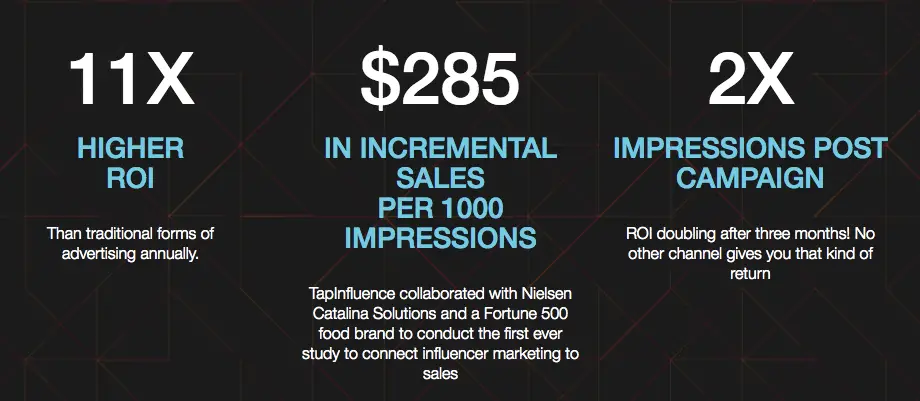
Traditional marketing was effective 50 years ago but not today. It’s time to start throwing money in the trash and invest in marketing that generates results worthwhile.
This is one of the most significant and talked-about influencer marketing statistics. The reason for that is that many marketers are still holding onto traditional forms of advertising such as television and radio, even though they have proven to be able to generate low ROIs, but at the same time, this is one of several influencer marketing statistics that prove that even though many brands hold onto the past, many brands realize where the future is heading and which marketing efforts drive great ROI:s. Because by looking at these influencer marketing statistics alone, there really isn’t a reason to throw money in the trash when there are so many other marketing opportunities out there.
31. Nearly 40 percent of Twitter users report having made a purchase as a direct result of a Tweet from an influencer.
It’s true! People buy products recommended by an influencer because they trust them. Just make sure you choose influencer to partner with caution so that the message comes off as authentic.
32. 70 percent of internet users report that they want to learn about a product through content before traditional advertising.
Content is king but context is queen. Content marketing is important for convincing your audience to buy from you, but it’s even more important that the content is shared in the right way and by the right influencers.
33. 33 percent of people say that they rely on bloggers to guide them to a purchase.
Blogging influencers tend to sometimes be forgotten, but they are individuals who have built a strong community and have strong relationships with their readers.
Web Solution Winner – The World’s Most Successful Blog the USA.
34. 89 percent of brands use influencer marketing to create authentic content.
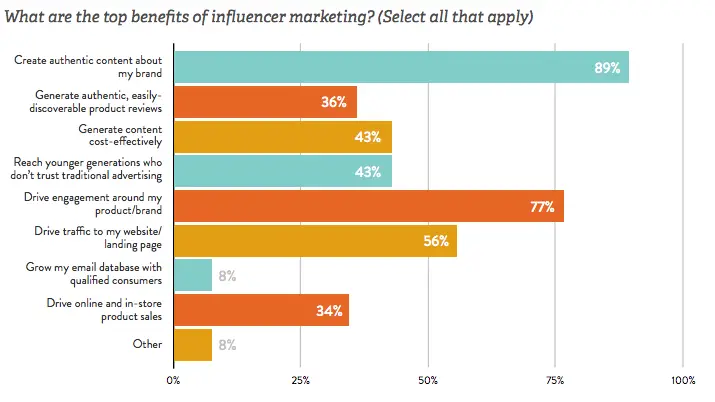
Influencer-generated content is far more trustworthy to customers, even if it’s later shared by the brand. Partner with influencers to get content that bears the trust that your brand only can dream about.
35. Social media is the number one driver of all referral traffic, standing for 31 percent of all referral traffic.
Influencer marketing can drive a ton of traffic to your site, but in order to do so, it’s important that you have defined it as a goal of your influencer marketing efforts.
36. 57 percent of marketers found that influencer-generated content performs better than professionally produced assets.
We just read that 89% of brands use influencers to generate content, so it’s not a surprise that influencer-generated content comes with a huge benefit. Influencer-generated content is far more trusted than professionally produced assets, even if the latter holds a much higher standard.
37. 59 percent of micro-influencers think Instagram is the most effective social media platform to engage their target audience.
When micro-influencers who are the ones that know their audience the best say that Instagram is the most effective platform to engage their target audience, it says something about the platform. When the influencer generates good results, it means good results for you as a brand, as well. When choosing a social platform, have this in mind.
38. 72 percent of customers trust a business more after it is recommended by an influencer.
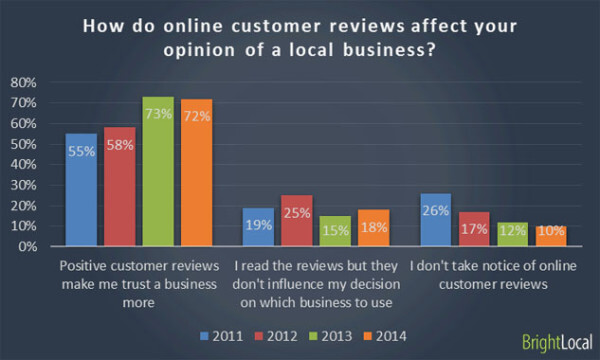
When influencers recommend you as a brand, a bit of the trust they have is transmitted to you. Partner with trusted influencers regularly and become a brand that your audience listens to.
39. Half of the internet’s users never click on an ad online. 35 percent of internet users click on less than five ads a month.
Banner ads are losing efficiency and brands need new ways to reach their target audience and convert them into customers. The decrease in interest in banner ads has led to a dramatic increase in influencer marketing growth.
40. 49 percent of marketers and communications professionals say they find influencer marketing to be “very effective” when it comes to achieving their visibility objectives.
To achieve your objectives with increased visibility, you first need to define what exactly you want to achieve. 49% of marketers say that influencer marketing is very effective, but for you to know if it is, you first need to know what you want to achieve.
41. 93 percent of marketers report that they are getting results in improving their visibility with the help of influencer marketing.
Influencers have exposure at their fingertips and can introduce you to an incredible number of people in a matter of seconds. By piggybacking off of influencers, you can get your product in front of thousands, maybe even millions at a fraction of what it costs to gain the same exposure from display ads.
42. 75 percent of professionals think influencer engagement is effective in lead generation.
43. For 67 percent of surveyed marketers, content promotion is the main benefit generated from influencer marketing.
47. 23 percent of marketers work with influencer marketing for SEO purposes (and find great success from it).
Influencer marketing also has SEO benefits. By partnering with blogging influencers (first and foremost), you can get your website to rank higher in search engines and as a result, gain more traffic long after the campaign has ended.
48. 68 percent of marketers consider Twitter a key channel for influencer marketing.
Twitter is a quick and simple way to interact with your audience, and the same goes for influencers. Influencers work as message birds, and what better place to use a message bird than on Twitter?
49. Extending the brand’s community is the driving motivation for influencer marketing, according to 55 percent of communication professionals.
50. 55 percent of marketers say the driving motivation of influencer marketing is to reach new audiences.

Influencers generally have access to a lot more people than brands have. Not only do influencers have the opportunity to reach more people, but they also have the opportunity to reach the right people, and people who truly matter to the brand. If the brand partners with an influencer who is suitable, that is.
51. Influencers with 10K-100K followers (micro-influencers) generate the highest engagement and reach, compared to the price they charge for sponsored posts.
Micro-influencers are known for generating the best results for the least amount of money. Micro-influencers have a more targeted and highly engaged audience, and this is the reason it’s able to generate the results it does.
52. Respondents are trusting images from other consumers on social media 7X more than traditional advertising.
Previous customers work as brand advocates and can be described as a form of influencers. Encourage happy customers to share their experiences, and share testimonials.
53. 56 percent are more likely to buy a product after seeing it displayed in a positive or relatable light, on social media.
When people see a product recommendation from an influencer they relate with, they tend to trust it. Even if they don’t know the influencer, the influencer has built trust with its audience and is, therefore, more likely to get listened to.
54. Content marketing is 62 percent less expensive than traditional advertising yet drives nearly 3X as many leads.
Pay less, and get better results. Sounds like a great deal. This statistic alone explains why we’re seeing a transition in the world of marketing, and that display advertising is losing traction like never before.
55. 70 percent of influencers think that the most effective ways to partner with brands are through an influencer marketing platform.
With influencer marketing platforms like Veloce Network, the partnership process is simplified and made easy for both the brand and the influencer. Brands can also achieve their true potential and make sure they get the most out of their marketing budget by taking help and guidance from an influencer marketing platform that recommends the most suitable and laser-targeted influencers.
56. 30% of consumers are more likely to purchase a product that has been recommended by a non-celebrity blogger.
People trust celebrities less, and trust influencers more. People are used to celebrities selling out, and influencers have a stronger relationship with their audience, which allows them to have a greater impact on their audience. And then, we cannot forget the fact that people have a lot easier resonating with influencers than with celebrities, which further increases the convincing power.
57. Only 3% of consumers would consider buying a product in a store if it was endorsed by a celebrity.
Back in the day, celebrities were everything, and they were the people that you looked up to. But now, it’s a whole lot different. People don’t seem to resonate with them very well, thus having less impact on their promotions on social media.
58. YouTube is the second most influential social media platform when it comes to convincing purchases. When it comes to customers, 18% of consumers are influenced by YouTube videos from influencers
YouTube is a visual social media platform where influencers can share videos in which they interact and engage with their audience. And it’s not that strange that YouTube is the second most influential social media platform because humans resonate a lot better with visual content than text.
This allows the influencer videos to have a much bigger impact on their audience, which ultimately convinced them to buy.
59. Individuals who are between 13 and 24 are two times more likely to evaluate influencers based on their followers, compared to older audiences.
People have different ideas and thoughts about what a social media is, and clearly, the younger generation defines a social media influencer by their follower count.
60. 56% of consumers are influenced by their friends and peers on their purchases.
61. Men are 2 times more likely than women to be influenced by blog reviews while shopping in-store.
If your target audience consists of men, leveraging blog reviews might be a good idea to convince your customers to convert.
62. 34% of people don’t mind if a post was sponsored, as long as it provides value.
Some marketers and some brands are terrified of disclosing that the post is sponsored in the belief that it will lead to less trust and worse results, however, if you make sure that the post provides value, it will be appreciated either way, but a lot of people.
63. 37% of respondents said they don’t mind a sponsored post as long as it is high-quality.
When running an influencer campaign, there are two things you want to think about campaign-wise. Firstly, you need to make sure that your post provides value, and second, you can never compromise on the quality of the post.
64. 1 in 3 18-34-year-old has made a purchase based on sponsored posts.
Influencer marketing is clearly impacting people into purchase decisions – especially when it comes to people aged under 40. If your target audience consists of people who are 34 years old or less, you’re missing out if you aren’t using influencer marketing.
65. 67.6% of marketers say that finding relevant influencers is their largest influencer marketing challenge.
Considering the fact that there are so many things you need to have in mind when identifying suitable influencers that will help you achieve great results, it’s not that strange that marketers say that finding suitable influencers is a big challenge. This is the reason why so many marketers and brands turn to influencer directories like Veloce Network in order to simplify their influencer identification process.
66. 70% of teenage YouTube subscribers report that they relate better with YouTube creators than with traditional celebrities.
If I’d said this ten years ago, no one would believe me, but that’s where we are today, and that’s the state of trust between people and celebrities.
This list of influencer marketing statics will continuously be updated as new studies are made.
67. 70 percent of millennial individuals are influenced by peer recommendations.
You’d expect this to only go for people they know, but the fact of the matter is that this goes for influencers, too, and this just shows the immense trust influencers actually have, even to the point where they have just as much influence as people’s friends.
68. 74 percent of people trust social media networks to guide them in their purchase decisions
This goes to show that people aren’t turning to TV ads, the newspaper, and so on, for purchase advice, but instead, the majority of people rely on social media to guide them in their purchase decisions, and those who do guide people in purchase decisions on social media are influencers. In fact, most influencers see it as their duty to guide their audience on social media.
69. 67 percent of marketers leverage influencers to promote their content
More and more brands realize the immense power that lies in influencer marketing, and this influencer marketing statistic proves that. Because just a few years ago, that number was far from that high, meaning influencer marketing is rapidly changing.

70. In 2017, influencer marketing became a billion-dollar industry.
71. Among marketers, 75% say that verified website traffic to an influencer’s site is the most crucial criterion when selecting influencers to partner with.
Different brands have different strategies for how they’re going to identify relevant influencers for their brand and campaigns, but those that are experienced in influence marketing can all agree on the fact that follower count is a dangerous metric to look at, instead, it is the true influence and the engagement that is interesting. Because anyone can buy a ton of followers on social media, but not everyone can impact people and influence their decisions.
72. While the searches on Google have skyrocketed for the term”influencer marketing”, the term “print advertising” has decreased at a similar pace.
More and more brands realize the inefficiency of traditional print advertising and its inefficiency for many reasons. At the same time, more and more people have discovered the amazing potential of influencer marketing.
73. 57% of fashion and beauty companies use influencers as part of their digital marketing strategies
The beauty and fashion industries are two of the industries where there are most influencers operating, but also most brands promoting in.
74. An adblocker report by AdFair shows that the use of adblockers has increased by 30% in 2016.
With reports that people are less responsive to traditional display ads, brands need to find new and more effective ways to reach their target audience.
75. A PageFair report says that 11% of internet users worldwide have enabled ad blockers on their computers.
The click-through rate on display ads has decreased dramatically and so has the percentage of people who see them.
76. According to a study by Influencer Marketing Hub, there has been a 325% in Google searches for the term “influencer marketing” in a year.
Google searches are often an indication of the popularity of things, and influencer marketing is no different.

77. A study by Markerly that analyzed more than 800,000 Instagram accounts where the majority of them had less than 1000 followers found that those types of influencers receive an 8% like vs follow rate.
When partnering with influencers, you shouldn’t just focus on the follower count. Micro-influencers generally have a lower follower count but a more engaged audience. This means that you can get better marketing results at a lower price by partnering with influencers that have fewer followers but that are more engaged.
78. Influencers with less than 1000 followers have a comment rate of 0.5%.
79. Instagram influencers with more than 10 million followers receive an engagement rate of 1.6%.
More followers don’t always mean better results for a brand. It is better to focus on the engagement of an influencer rather than their follower count.
80. Influencers on Instagram with more than 10 million followers only see a comment rate of 0.04%. More followers aren’t always better when it comes to influencer marketing.
Influencers often base their prices on follower count, and what you need to think about is the engagement-to-follower ratio because ultimately, that is what will have the biggest effect on how the campaign performs.
81. According to a study, 42% of micro-influencers use Instagram for sponsored posts.
82. According to a study by Bloglovin, 35.5% of micro-influencers follow H&M on Instagram.
If you want to catch the attention of a micro-influencer you want to partner with, consider taking a glance at H&M to understand what they are doing right. This also proves that mass brands are more popular than luxury brands because they’re more accessible.

83. 96% of influencers surveyed report that they charge less than $1000 for a single sponsored blog post.
You don’t have to pay hundreds of thousands of dollars to people like the Kardashians to get exposure and drive results with influencer marketing. Today, influencer marketing is accessible to everyone – no matter what marketing budget.
84. Of surveyed people, 90% of influencers reported charging less than $250 for a sponsored marketing post.
This is one of the influencer marketing statistics that prove that influencer marketing isn’t a marketing tactic that’s only available for the fortunate few. Instead, due to its low costs of getting started, virtually any brand can get started with it today, and drive impressive results despite the few invested dollars.
85. 90% of respondents in a study said that they charged less than $150 for every sponsored tweet.
Of course, you won’t see the major celebrity influencers charge less than $150 for a sponsored tweet, however, since many of these influencer marketing statistics have proven the immense power of micro-influencers, you can drive great results from influencer marketing, even by partnering with influencers that have a smaller following.
86. 53% of micro-influencers in the survey said that they have never made any type of paid promotion or endorsement on their social media.
A characteristic that often defines many micro-influencers is that they are authentic, and genuine, and feel the responsibility of guiding their peers to guide decisions.
A reason that many micro-influencers haven’t done a paid promotion or endorsement can be that they just don’t want to risk losing their badge of authenticity and being called a sell-out. Another reason can be that they just don’t have any interest in it. They do what they do because they have a genuine passion for it, and if they can build an audience of fans on the way, that’s great. Therefore, imagine the arbitrage in people’s attention with micro-influencers that haven’t done any promotions, because they haven’t yet realized their true potential and leverage.
87. 96% of people asked in a study by BlogLovin’, reported that they charge less than $500 for every sponsored post they make on Facebook.
88. According to a study by Bloglovin’ which surveyed plenty of micro-influencers, 89% of micro-influencers said that they post content on blog platforms such as WordPress, or Blogspot.
Don’t just take for granted that an influencer on Instagram is an influencer solely on Instagram.
Not only do most influencers have a presence on other social platforms, but many also have a blog as well.
89. A study by Crowdtap found that 76% of influencers value brands that provide them with creative freedom when setting up a campaign.
This is a huge mistake that brands make in their influencer marketing campaign setup. The influencers have worked with building their presence and pushing out content for years, so who do you think knows the audience of the influencer best? The brand or the influencer who has spent years engaging with them and understanding what they like and dislike?
The answer is quite obvious. Therefore, make sure you give the influencers you partner with creative freedom, and let them do what they do best. Because all real and authentic influencers know what they are doing, and they want to help you drive the best possible results.
90. 63% of social media users say that consumer ratings are the single most important thing when deciding whether to buy something.
People trust consumer ratings, but do you know what they trust even more? Consumer ratings from people they look up to and trust greatly.
In other words, influencers.
By having an influencer recommend your brand. you’ll get consumer ratings that are far more powerful than any other type of consumer ratings.
91. 67% of influencers say they are happy to work with brands that provide fair and competitive compensation.
When you partner with an influencer, you enter a relationship with them.
Remember that no relationship is ever sustainable if one of the two parts of the relationship isn’t satisfied, and feel like they’re being used.
A relationship needs to be win-win where both parties feel like they’re getting something from it in order to be beneficial. Therefore, don’t take advantage of the influencers you partner with, but instead, give them fair compensation.
92. In just 24 four months, over 230 influencer marketing dedicated agencies and services have emerged. This obviously also includes Veloce Network.
With the increased interest in influencer marketing, there’s also an increased number of question marks and confusion around the topic. People want to get started with influencer marketing, but they just don’t know how to set up a campaign successfully, what to pay the influencers, and maybe most importantly, how to identify suitable and relevant influencers, which Veloce Influencer Network helps you with.
93. According to a study by Influencer Marketing Hub, 57% of brands have stand-alone budgets for content marketing
Content marketing is a central part of influencer marketing, and since one of the influencer marketing statistics proved earlier, influencer-generated content performs far better than professionally created content since it is far more trusted. This means that brands can work with influencers just to get powerful content.
94. According to the same Influencer Marketing Hub study, 37% of marketers in the survey set aside budgets for influencer marketing.
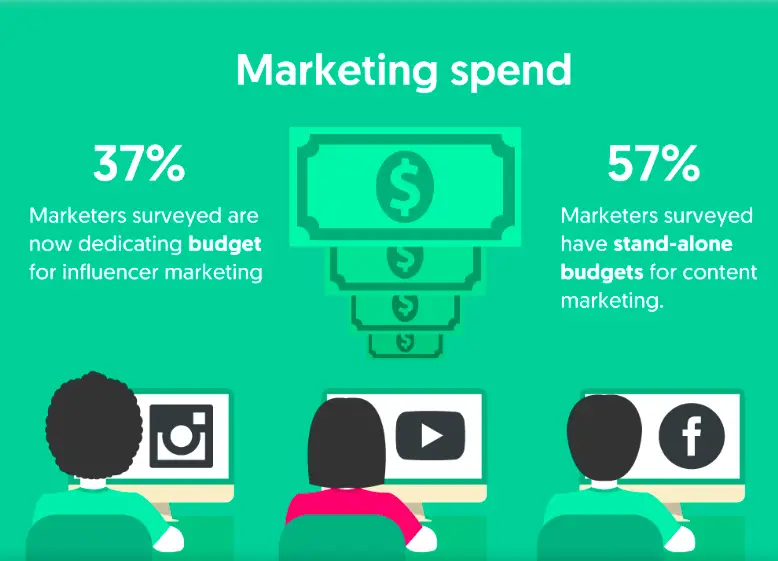
95. A study shows that influencer marketing is 2 times faster in acquiring customers than organic search.
Since people’s attention is on social media, this is maybe not very surprising, because where people’s attention is, that’s where brands are able to reach them, and impact them into buying from them. In this case, with the help of influencer marketing.
96. Influencer marketing is 10 times more effective than affiliate marketing in new customer acquisition online.
What’s interesting about this is that influencers can enter affiliate marketing partnerships with brands as a form of getting rewards when they drive sales, for example by getting their own discount code, however, what this influencer marketing statistics refers to is affiliate marketing that is done by people who aren’t influencers. And this isn’t very strange after all, since people don’t look up to brands or unknown people the same way they do to influencers.
97. 81% of consumers are known to frequently buy the items they’ve seen being shared on social media.
This is one of the influencer marketing statistics that prove that people are influenced by influencers on social media into buying things. There are still people that argue that influencer marketing doesn’t work, but it’s hard to deny this statistic.
98. 94% of consumers on social media buy new food ingredients as a result of being influenced by social media recipes or photos shared by influencers.
This influencer marketing statistic is great news for brands in the food industry because it opens up new opportunities for them to impact and sell their products.
By partnering with food influencers on social media as a food brand, you can have the influencer share recipes and photos of your products, and in that way drive engagement to your brand, but also have the influencer share content that provides the audience with value.
99. According to Bloomberg, $255 million is spent on influencer marketing every month, but that number is set to rise dramatically over the years.
This number is steadily increasing, and it is estimated to continue to increase over the years.
100. 60% of audiences on YouTube are influenced by YouTube influencers in their purchases.
It has been found that YouTube influencers have a greater influence than influencers on other social media platforms.
This is not very strange since influencers on YouTube can build stronger relationships with their audience, and show a greater personality that people will be able to resonate and relate with, in a way that is hard to do on other social media platforms.
101. According to a Google study, fans are more engaged by social media influencers than celebrities. In fact, the top YouTubers get 3x more views on their videos as compared to celebrities.
This is just one of several influencer marketing statistics that prove that in terms of brand endorsement and having the power of influencing people, social media influencers are increasing in authority, and as a result, they’ll be more effective as brands to leverage in marketing, rather than having celebrities promote and endorse your brand, which was the ultimate thing to do just a few years ago.
102. According to the study, the top 25 YouTube influencers get 2x more engagement and 12x more comments than traditional celebrities.
YouTube is a very engaging platform since influencers can showcase their personality and their life, and in that way be more engaging and relatable. As a result of the improved relationships between the influencer and their audience, the audience will be more engaged.
103. 70% of teenage YouTube audiences are influenced more by YouTubers than traditional celebrities.
If you’re a brand that is targeting teens, YouTube is the platform where it is at. If you’re going to work with influencer marketing (which you should), you should work with YouTube influencers.
104. According to a report, 40% of millennial YouTube audiences feel that their favorite YouTubers understand them better than their friends.
This is quite extraordinary information if you ask me, and gives us an idea of where the world is going.
105. Less than 1% of mothers are influenced by celebrity endorsements when making a purchase.
If you want to target mothers with influencer marketing, you’ll be far better of partnering with micro-influencers, because the vast majority of mothers aren’t very influenced.
106. 48.3% of mothers are not influenced by celebrity endorsements or advertising in their buying decisions.
107. One-third of Twitter users follow and engage with social media celebrities and influencers regularly.
As a brand, you always want to be in touch with your audience and reach new audiences, and since a whopping one-third of people engage with influencers, you can use influencers as middlemen to connect you with your target audience.
108. 56% of consumers on Twitter are influenced by their friends and peers on their purchases
People see influencers who they look up to as their friends, and what’s more, social media influencers are also the peers of their audiences.
In other words, not only are people influenced by their friends, but they are also greatly impacted by influencers, and by partnering with social media influencers, you can impact your audience at scale.
109. 20% of Twitter users are likely to retweet a product recommendation tweet that was initially shared by an influencer.
This allows the tweet to gain further reach outside of the influencer’s follower base and drive the brand more exposure.
110. Only 25% of respondents in a study conducted by Bloglovin’ thought that brands have a realistic idea of influencer marketing costs.
That many brands don’t have a very good idea of how much influencer marketing costs isn’t very strange considering that influencer marketing is still very new if you compare it to traditional marketing. But it’s not only brands, though.
Influencers are also having a hard time deciding prices for promotions since they don’t have a lot to compare with.
As a brand, you can read this article to get a better idea of what the true cost of influencer marketing is.
111. A study conducted by The Collective Bias found that 22.8% of men are influenced by YouTube in their buying decisions.
If you’re a brand targeting men, YouTube is a great platform to partner with influencers on. In fact, it’s even more effective if you are targeting males who are also teenagers since teenagers are often turning to YouTube for inspiration advice, and more.
112. 34.4% of men are influenced by blog reviews for consumer electronics purchases.
This influence marketing statistic is great to know if you’re in the business of consumer electronics.
113. While shopping at a store, 60% of consumers have been influenced by a social media post or a blog review. This is according to the Collective Bias study.
This is one of several influencer marketing statistics that prove that influencer marketing doesn’t just go for e-commerce businesses.
Many brick-and-mortar businesses that have no commerce shop tend to neglect influencer marketing with the argument that it doesn’t work, but clearly, it does.
Moreover, this influence marketing statistic is also relevant for the brands that maybe have retailers or maybe have both. Influencer marketing doesn’t just work for e-commerce, but it works to impact in-store purchases as well.
114. According to Shane Barker, Facebook is the most influential social channel per the results of the survey. 19% of consumer purchase decisions are influenced by Facebook posts.
This statistic maybe doesn’t come as a surprise when you consider the fact that Facebook is also the world’s largest social media platform. This is also part of the reason why Facebook is the social platform that most brands are using. But with the limited organic reach, partnering with influencers on Facebook is a great idea to amplify your messages and receive a greater reach.
115. 70% of millennial consumers are influenced by the recommendations of their peers in buying decisions. An influencer marketing survey conducted by Collective Bias involving 14,000 respondents in the US, reveals this influencer marketing statistic.
116.YouTube influences 13.9% of women in their purchases.
This influencer marketing statistic prove that it’s not only males that are using YouTube and being impacted by it. The fact of the matter is that women use Youtube at least as much as men, and so if you’re a brand targeting females, working with influencer marketing on YouTube is a great way to reach people in a way that impacts them and influences their buying decisions.
117. A study by McKinsey found that “marketing-induced consumer-to-consumer word of mouth generates more than twice the sales of paid advertising.”.
What social media has done is give us the opportunity to reach a ton of people at once, compared to just being able to talk to one or two people at the same tie in real life. This is great news for brands because by partnering with social media influencers, they can get a much greater reach with their promotional messages, and therefore reach more people but with less effort than going door to door and letting people know about your products.
The best part is that influencer marketing tends to lead to further word-of-mouth discussions.
118. 70% of YouTube users see YouTube stars and influencers as trendsetters.
As a result, these individuals become very powerful when it comes to influencing consumer behavior.
119. According to the same study, 32% of females say they most often turn to Pinterest for shopping inspiration.
Pinterest is a female-dominated social media platform, so if you want to reach and impact your female prospects, Pinterest is a great platform, and to amplify your message and gain traction right from the word go, influencer marketing is the tactic you want to opt for.
120. According to a study, 38% of social media users say they most often turn to Facebook for shopping inspiration.
121. Instagram is the favorite social platform for micro-influencers. In fact, 80% of micro-influencers asked in the study said that they use Instagram to post original content.
122. 47% of influencers asked in a study reported that editorial guidelines shared by brands are often very limiting.
Commonly asked questions
Which industry uses influencer marketing the most?
Influencer marketing is used across a wide range of industries, but some industries tend to use it more heavily than others. According to various studies, the following industries are known to use influencer marketing the most:
- Fashion and Beauty: These industries rely heavily on visual content, and influencers with large followings on platforms like Instagram and YouTube can help to showcase products and create buzz around new collections and trends.
- Travel and Lifestyle: Influencers with a focus on travel and lifestyle often have a large following and can help promote destinations, hotels, and travel brands. They can also create a sense of aspirational living and showcase a brand’s products or services in a more relatable way.
- Technology and Gaming: These industries often use influencers to promote new products and services, but also, to create buzz around upcoming releases and events. Influencers can help to create a sense of excitement and anticipation around a new product or game.
- Food and Beverages: Influencers can help to promote new food products and restaurants, but also showcase recipes and cooking techniques. They can also create a sense of community and interest around new food products and trends.
- Fitness and Health: Influencers in this industry are often seen as experts in their field and can help to promote new products and services, but also create a sense of community and motivation around healthy living.
What is KPI in influencer marketing?
KPI stands for Key Performance Indicator. In the context of influencer marketing, KPI’s are metrics that are used to measure the effectiveness of an influencer marketing campaign and to determine whether it has met its goals. Some common KPI’s used in influencer marketing include:
- Reach: The total number of people who have seen the influencer’s content, including their own followers and any additional audience that the content has been shared with.
- Engagement: The level of interaction that the influencer’s content has received, including likes, comments, shares, and other types of engagement.
- Impressions: The number of times that the influencer’s content has been seen by their followers and other users.
- Click-through rate (CTR): The number of clicks on a link or call-to-action (CTA) within the influencer’s content.
- Sales: The number of sales or conversions that can be attributed to the influencer’s content or campaign.
- ROI: The return on investment of the campaign, which can be calculated by dividing the revenue generated by the campaign by the cost of the campaign.
It’s important to note that not all KPI’s are relevant to all influencer marketing campaigns, and the specific KPI’s that are used will depend on the campaign’s objectives and goals. It’s also important to understand that influencer marketing is a long-term strategy, and it’s important to track the progress and adjust the strategy accordingly to maximize the results.
What age group is most influenced by influencers?
Influencer marketing can be effective across a wide range of age groups, but the age group that is most influenced by influencers tends to vary depending on the platform and the niche.
According to studies, younger generations are more likely to be influenced by influencers, with the majority of social media influencers’ audience falling between the ages of 18-34. However, it’s important to note that influencer marketing can be effective across different age groups as well.
On platforms like Instagram, TikTok, and YouTube, influencers tend to have a younger audience, with many of their followers falling between the ages of 18-24. These platforms tend to be more visually-oriented and are often used by younger generations to discover new products, trends and keep up with their favorite celebrities or influencers.
On platforms like Facebook, LinkedIn and Twitter, the audience tends to be a bit older, and influencers often have a more professional or business-oriented focus. These platforms tend to be more text-oriented and are used by older generations to discover information, news, and ideas on business, professional development, and personal growth.
It’s also important to note that influencer marketing can be effective within specific niches, regardless of the age group. For example, an influencer who focuses on health and wellness may have a following that spans across different age groups, while a fashion influencer may have a younger audience.
It’s important for brands to identify the right influencer for the right audience and make sure that the message and the content aligns with the target audience’s interests and needs.
Conclusion
To say the least, these influencer marketing statistics are quite impressive.
Not only do these influencer marketing statistics prove just how much and how quickly influencer marketing has grown in just a few years, but these statistics also show just how powerful influencer marketing is at driving marketing results.
When looking at these influencer marketing statistics as a marketer, it’s natural to ask yourself why you aren’t implementing influencer marketing in your marketing strategy, if you aren’t already. Because the statistics are just too good to neglect.
Were you impressed by these influencer marketing statistics? Were any of these influencer marketing statistics completely new to you, and were some old?
Let us know in the comment section below!

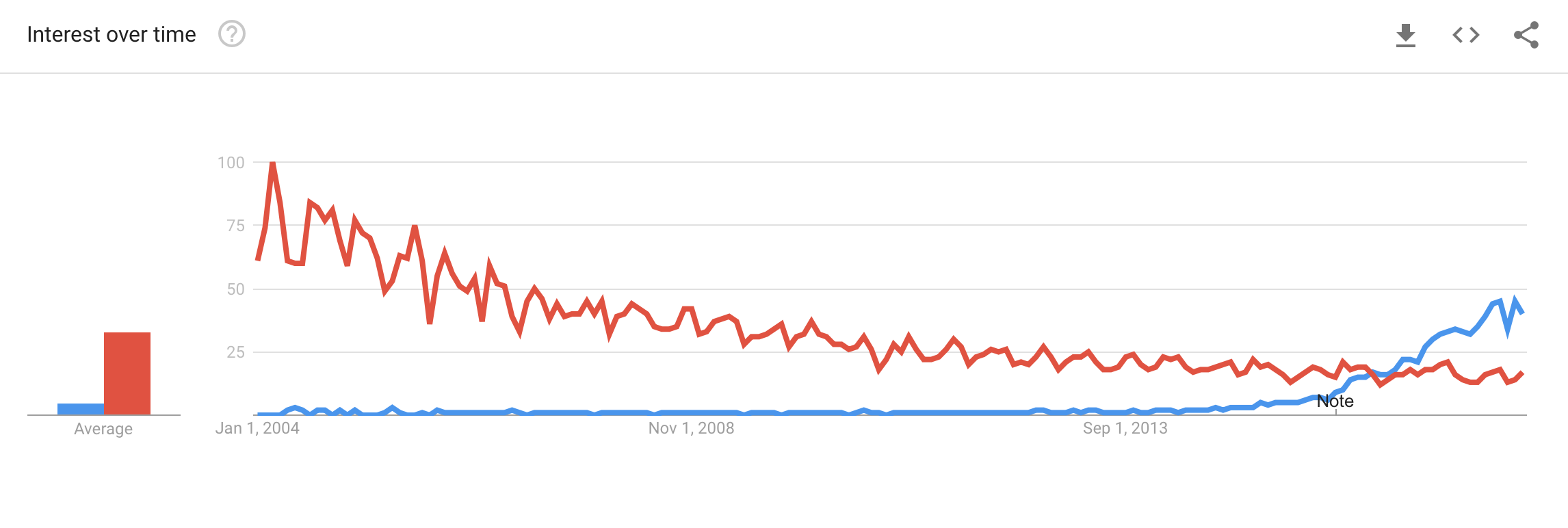






[…] marketing may be a dying fad. To be honest, I just don’t see how that is possible. About 60% of consumers trust the advice of a social media creator over that of movie and television […]
[…] Think long-term. Keep in focus to keep the customer for twenty years. […]
[…] Influencer marketing has proven to be an effective strategy to expose your company and products to a larger market. Consider these stats: […]